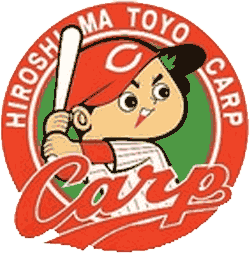After more than a week in Hiroshima, it was time for the ultimate evening escape for a baseball fan: a Hiroshima Toyo Carp game. At my request, the foundation sponsoring my month-long research trip to Hiroshima and Nagasaki had secured seats for the visiting journalists right behind home plate, about eight feet from the screen. Naturally a TV crew came along to catch our reaction, or perhaps the Japanese fans' reaction to us.
Thanks to my interviews with Sadaharu Oh and Roy White (the former Yankees star who then went to the Tokyo Giants) a few years back, I knew quite a bit about Japanese baseball. It had been around for at least half a century. One of the U.S. military team that I write about in my new book Atomic Cover-up told me he filmed boys playing ball in the atomic ruins (the footage was suppressed for decades). Hiroshima's stadium was a somewhat ramshackle, single-level shell, about the size of a Triple A park in my country. Its location: directly across from ground zero, no more than a couple of home runs away.
Taking a seat at the stadium proved unnerving. For one thing, the A-Bomb Dome loomed over the third base rim of the stadium, a reminder that this ball field was once a killing field. Then there were the fans, laughing and pointing at us: Look at the Americans watching the American pastime in Hiroshima (of all places). The irony was so thick you could cut it with a ... bat.
To welcome its first pro team, Hiroshima erected the stadium in the early 1950s. The mayor hoped baseball would "revitalize the spirit of Hiroshima," and make the citizens forget what had happened on August 6, 1945, four decades before my visit. Yet he built the stadium 300 yards from the epicenter of the atomic explosion.
There was no evidence that the fans felt particularly uncomfortable in this setting. A majority of adults in this city were survivors of the bomb, or lost parents that day, or were related to hibakusha, yet thousands come to this spot where so many perished to drink beer and cheer. Among the players they applauded were hired mercenaries from the country that dropped the bomb on their relatives (or themselves).
Out of guilt or uneasiness, I found myself cheering loudly for the Carp, as if this could somehow compensate for the decision to drop the bomb. Still, this was once a killing field, and any fan raising his or her eyes could see that spot in the sky where the bomb went off.
For a baseball fan from New York, it was hard to enjoy the game. At Yankee Stadium you get a screeching subway; at the Mets' home field, jumbo jets from LaGuardia. At Hiroshima Stadium, for decades, you got the A-bomb Dome over your shoulder. It is often said that the ghosts of Babe Ruth and Lou Gehrig haunt Yankee Stadium. One did not want to think too deeply, especially at a baseball game, about the apparition potential at Hiroshima Stadium.
There is this postscript: A new baseball stadium for the Carp, located closer to Hiroshima Station than the A-Bomb Dome, opened in 2009. Naming rights were purchased by Mazda, whose main auto plant for Japan is located on the outskirts of the city. (It was only partly destroyed in 1945, as I learned in a visit there.) The formal name for the new structure is the Mazda Zoom-Zoom Stadium.

No comments:
Post a Comment